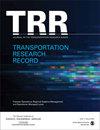Evaluation of the Trade-Off between Ground Delays and Intersecting Departures under Various Pilot Acceptance Rate Scenarios
IF 1.8
4区 工程技术
Q3 ENGINEERING, CIVIL
引用次数: 0
Abstract
The increasing demand for air traffic at airports necessitates the efficient utilization of ground facilities such as runways and taxiways. Intersecting departures, in which one or more aircraft take off from intersecting points on the runway, is a commonly used approach to increase runway capacity and reduce ground delays and taxi times, as well as noise and air pollution. However, the procedure carries potential risks such as runway incursion and excursion. This creates a trade-off between minimizing the number of intersecting departures and minimizing ground delays. In practice, the decision to perform an intersecting departure is ultimately up to the pilot, resulting in uncertainty in the acceptance rate of these types of takeoffs. In this study, a departure sequencing model was developed for a single-runway airport that considers intersecting departures and various pilot acceptance rate scenarios. The primary objective of the model is to minimize total ground delay, including taxi delays, runway holds, and conflict holds. The secondary objective is to minimize the number of intersecting departures by directing the most operationally critical aircraft to the intersection takeoff. The epsilon constraint method—a multi-objective scalarization method—was used to reveal the trade-offs between the objective functions. The results of the model were compared with a traditional scenario that only allows take offs from the beginning of the runway. As a result, average delay savings ranged from 17.1% to 31.5% in various acceptance rate scenarios, as well as average taxi time savings ranging from 4.9% to 8.4% compared with the traditional scenario.不同飞行员接受率情景下的地面延误与交叉离场权衡评估
机场对空中交通的需求日益增加,因此必须有效利用跑道和滑行道等地面设施。交叉起飞,即一架或多架飞机从跑道上的交叉点起飞,是一种常用的方法,以增加跑道容量,减少地面延误和滑行时间,以及噪音和空气污染。然而,该程序有潜在的风险,如跑道入侵和偏移。这就需要在尽量减少交叉起飞次数和尽量减少地面延误之间做出权衡。在实践中,执行交叉起飞的决定最终取决于飞行员,导致这些起飞类型的接受率存在不确定性。在本研究中,建立了一个单跑道机场的离场排序模型,该模型考虑了交叉离场和各种飞行员接受率情景。该模型的主要目标是最小化总地面延误,包括滑行延误、跑道等待和冲突等待。第二个目标是通过引导最关键的飞机到交叉起飞来最小化交叉起飞的数量。采用多目标标化方法——epsilon约束法来揭示目标函数之间的权衡。该模型的结果与只允许从跑道开始起飞的传统场景进行了比较。因此,在不同的接受率场景下,平均延误节省幅度在17.1%至31.5%之间,平均出租车时间节省幅度在4.9%至8.4%之间。
本文章由计算机程序翻译,如有差异,请以英文原文为准。
求助全文
约1分钟内获得全文
求助全文
来源期刊

Transportation Research Record
工程技术-工程:土木
CiteScore
3.20
自引率
11.80%
发文量
918
审稿时长
4.2 months
期刊介绍:
Transportation Research Record: Journal of the Transportation Research Board is one of the most cited and prolific transportation journals in the world, offering unparalleled depth and breadth in the coverage of transportation-related topics. The TRR publishes approximately 70 issues annually of outstanding, peer-reviewed papers presenting research findings in policy, planning, administration, economics and financing, operations, construction, design, maintenance, safety, and more, for all modes of transportation. This site provides electronic access to a full compilation of papers since the 1996 series.
 求助内容:
求助内容: 应助结果提醒方式:
应助结果提醒方式:


